What is the role of software testing in the renewable energy sector
Herman Scheer once said, “Our dependence on fossil fuels amounts to global pyromania, and the only fire extinguisher we have at our disposal is renewable energy.”
Renewable energy is a clean, abundant, cost-effective, and environment-friendly source of energy. Yet, renewable sources only made up 26.2% of the global electricity generation until two years ago. But now, with the decreasing costs of renewable energy, a pandemic, and recent climate change efforts, the global renewable energy market is projected to reach $2152.9 billion by 2025. Electricity consumption is expected to double until 2050, with an estimation that renewable sources will make over 50% of the generation by 2035. Even, for the first time in record, the United States is on track to produce more electricity this year from renewable power than from coal.
The transition toward a higher share of renewable energy creates complex challenges in designing, implementing, controlling, and maintaining the systems. Traditionally, the apprehensions regarding the adoption of renewable energy were due to their unpredictability. However, with smarter weather prediction systems driven by Artificial Intelligence and Machine Learning, real-time monitoring with IoT devices, easier maintenance with digital twin technology, efficient storage technologies, and more, the renewable energy sector is all set for a scalable adoption.
Digital transformation of the energy value chain has the potential to reshape the renewable energy industry while making the clean energy goals attainable. The future of energy is renewables, and the future of renewables is digital. As the energy and utilities sector is approaching a core transformation, it needs to ensure a smooth shift for ensuring speed, scalability, and stability in the services. This is where software testing services play a mission-critical role for the E&U sector. Let us talk about the technologies that are enabling the digital future of renewable energy, while outlining the necessity of software testing for each one of them.
Digital transformation for renewable energy
Before we talk about each of the technology separately, you should understand that all of them are a part of the bigger picture. Each of them has its own role to play in the digital transformation of the renewable energy sector. Individually, they improve the respective areas or systems. As a whole, the complete digital experience yields a customer-centric outcome.
- Big data and advanced analytics for intelligent asset management: In the renewable energy sector, data is pulled from a variety of sources, such as meters, loggers, or Supervisory control and data acquisition (SCADA). Without context and relevance, all the gathered data is rudimentary. By applying analytics to the data, renewable energy providers can shift from a reactive to a proactive, predictive, and prescriptive approach. Asset intelligence and smart data modeling work together to yield a satisfying customer experience by offering answers to the what, why, when, and how of renewable energy generation, distribution, and transmission. They offer a single source of truth, increase effectiveness and efficiency through process & workflow automation, facilitate data transparency, and ensure on-demand availability of the required information.
- Industrial Internet of Things (IIoT): Renewable energy is at the heart of all smart city projects and therefore, drives the Industrial Internet of Things. As the penetration of renewable energy deeps into the E&U sector, the need for energy & storage management solutions will rise. High-resolution sensors and remote inspection systems including drones offering laser-based measurements will be increasingly used for minimizing operation costs. The IIoT-driven interconnectedness would mean bringing different sensors, analytical systems, and processes together in such a way that every renewable energy project is connected across technologies to smart national grids, industries, buildings, and homes. Having such a level of connectivity will enhance the remote monitoring, supply & demand management, and predictive maintenance capabilities of the renewable energy companies.
- Artificial Intelligence and Machine Learning: Artificial Intelligence in renewable energy sector is essential for improving energy efficiency. By interpreting data for insights, AI supports forecast energy demand and energy-saving decisions. Coupled with machine learning algorithms, AI is capable of preventing shortfall or over-generation issues in the energy grids. Further, Artificial Intelligence and machine learning systems help automate the maintenance and operations activities in the sector. By integrating AI with the storage systems, the renewable energy industry can develop a sustainable and reliable storage solution in the form of smart grids. These smart grids can analyze huge volumes of data in real-time to for driving efficient energy allocation decisions. With smart & centralized control centers, microgrid integration, and control optimization, AI offers safety and reliability to the renewable energy sources.
Leading in the digital journey with software testing and quality engineering
The digital technologies not only enhance energy efficiency and help control climate change, but also address the challenges related to unpredictability, unreliability, and instability of renewable energy sources. As pointed out earlier, all of these technologies need to work holistically to yield the desired outcomes and gain measurable outcomes. However, bringing all of them together is the biggest challenge. Additionally, with the introduction of digital solution into a sector on which the global operations would depend also results in a higher vulnerability of cyber risks. Therefore, cybersecurity is one of the most essential components of a digital renewable energy ecosystem.
As the E&U landscape undergoes a massive transformation from existing systems to better ways of consumption, production, and distribution using digital solutions, software testing of those solutions becomes inevitable. Software testing and quality engineering services for the global E&U ecosystems ascertain the desired outcome of speed, scalability, and stability by supporting initiatives across change management, compliance programs, and executive monitoring. Employing performance engineering across the end-to-end systems can ensure efficient handling of load and stress on the applications in different geographical locations, resulting in higher credibility and trust among the end users. Investing in security testing solutions will help uncover security vulnerabilities before any actual cyber attack takes place.
How can we help
Cigniti’s E&U Center of Excellence offers a complete QA solution. While our SmartMeter Labs help smart grid systems improve the effectiveness of demand & supply management by improving the predictability and the reliability of power generated and transmitted, our cloud-enabled Performance Engineering Test Lab helps software applications achieve speed, scalability, and stability. We set up close-to-real test environments and deploy specialist performance engineering teams to ensure that load and stress testing can be conducted from different geographies, thereby saving our clients valuable time and money. Schedule a discussion with us to understand how we can help your company achieve digital excellence.





Leave a Reply